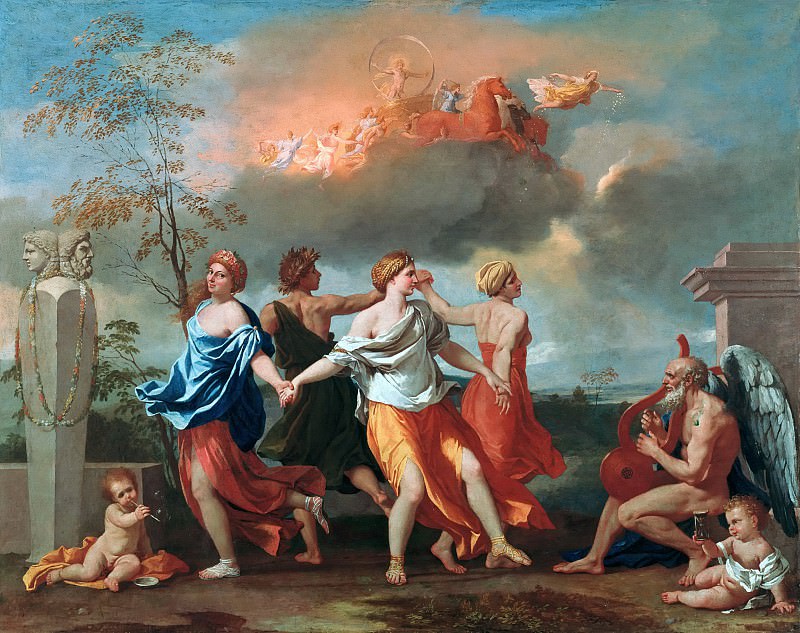A Dance to the Music of Time Nicolas Poussin (1594-1665)
Nicolas Poussin – A Dance to the Music of Time
Edit attribution
Download full size: 3118×2466 px (2,2 Mb)
Painter: Nicolas Poussin
Location: Wallace Collection, London.
The French painter Poussin frequently turned to themes of mythology. An outstanding work with the philosophical title Dance to the Music of Time was painted in Rome. The approximate time of creation of the grandiose canvas is 1638. Antique myths formed the basis of the painting by Nicolas Poussin. As the founder of classicism, the artist reflected the new style in this work. Everything in the painting is beautiful, harmonious, and perfect.
Description of the painting "Dance to the Music of Time" by Nicola Poussin
The French painter Poussin frequently turned to themes of mythology. An outstanding work with the philosophical title Dance to the Music of Time was painted in Rome. The approximate time of creation of the grandiose canvas is 1638. Antique myths formed the basis of the painting by Nicolas Poussin.
As the founder of classicism, the artist reflected the new style in this work. Everything in the painting is beautiful, harmonious, and perfect. The figures of mythical creatures and people are endowed with perfect proportions. The architecture surrounding them is beautiful and exquisite. Nature delights with refinement and natural splendor.
In the compositional center - dancing in a closed circle of 4 figures. The first one symbolizes Poverty - a barefoot young man in dark clothes. On the right, Labor holds his hand, then Rich. The red-haired girl with a sly smile, a symbol of Pleasure, closes the dance circle. Such allegorical whirlwind can be understood as a turning of Fortune’s wheel. Under the influence of fleeting chance and the prevailing circumstances of life, a person receives one of the four named states.
The other figures in the picture are two infants. One sits on the left, playing with soap bubbles. This is another symbolic image that reminds one of the transience of life. On the right, the infant follows the movement of the hourglass, which he holds in his hand. The winged elder Chronos is the embodiment of Time itself. He plays music to which he dances the round dance. The statue with two faces is the god Janus. The young face stares into the future, the second head of the bearded old man looks in the opposite direction - into the past.
The painter has placed a mythical object in the sky - Apollo’s chariot. In front of it flies the goddess Aurora and scatters flowers.
Poussin displayed in the "Dance to the music of time" allegory of human life. The masterpiece is now in the Wallace Collection in London.
Кому понравилось
Пожалуйста, подождите
На эту операцию может потребоваться несколько секунд.
Информация появится в новом окне,
если открытие новых окон не запрещено в настройках вашего браузера.
You need to login
Для работы с коллекциями – пожалуйста, войдите в аккаунт (open in new window).




















You cannot comment Why?
This painting, A Dance to the Music of Time by Nicolas Poussin, is a complex allegorical work.
What I see:
In the foreground, a circular dance of four figures takes place. They are moving in a lively circle, holding hands. The figures appear to represent different stages of life or different ages: one is crowned with flowers, another with laurel, and another with pearls. A baby is playfully blowing bubbles near the left side of the dancing group. To the right, a winged, elderly figure with a beard plays a lute, accompanying the dance. This figure also holds an hourglass, signifying the passage of time. Beside him, another baby sits, holding a skull, a symbol of mortality.
In the background, on the left, stands a herm, a stone pillar with a head, appearing antique and serene, perhaps representing wisdom or enduring knowledge. On the right, a fragment of a classical architectural structure can be seen.
The upper part of the painting is dominated by the sky, where a chariot pulled by horses, driven by Apollo, rises. Around him, various nymphs or goddesses dance in a celestial realm, with one showering what appears to be stars or light from above. The entire scene is bathed in a soft, diffused light.
Subtexts:
The painting is a profound meditation on the cyclical nature of life, time, and the universe.
Essentially, A Dance to the Music of Time conveys the idea that life is a continuous, ever-moving dance orchestrated by Time, encompassing birth, growth, decay, and death, all within a grander, possibly divine, cosmic framework. It speaks to the ephemeral nature of human existence against the backdrop of eternal cosmic movements.